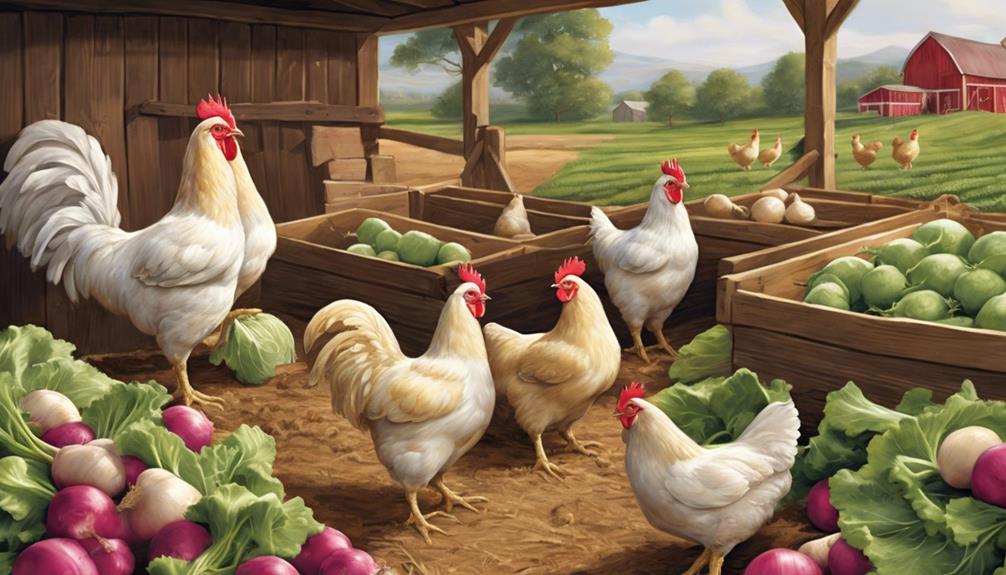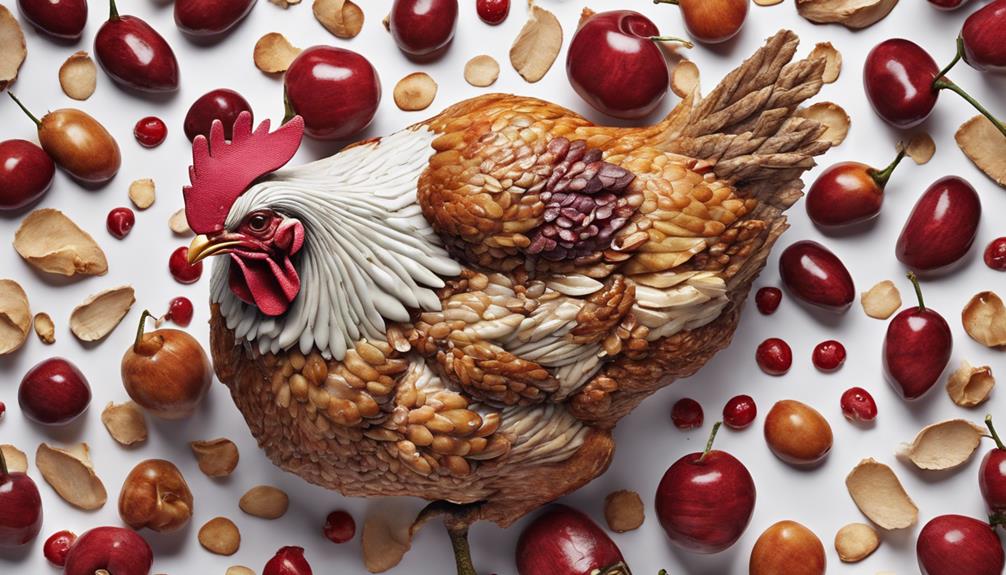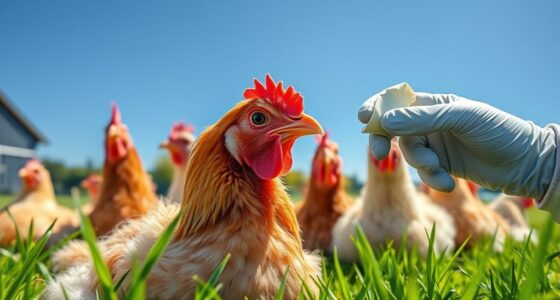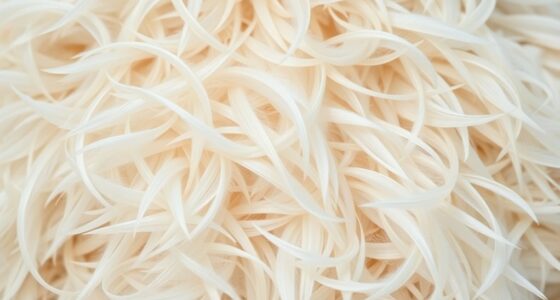When giving chickens romaine lettuce, it is crucial to properly prepare it by washing it thoroughly, cutting it into small pieces, and mixing it with their regular feed. Hang the lettuce in the coop for the chickens to peck at, and store any leftovers in the refrigerator or freezer to keep it fresh. Be cautious not to overfeed, as this can result in diarrhea, and consult a vet if your chickens show any signs of discomfort. Additionally, including a variety of vegetables such as spinach, kale, and dandelion greens can provide nutritional benefits to their diet. Introducing lettuce in moderation once or twice a week will help ensure your chickens stay healthy and happy.
Key Takeaways
- Wash thoroughly to remove any dirt or pesticides before feeding.
- Chop lettuce into small pieces to prevent choking hazards.
- Offer in moderation to avoid digestive issues like diarrhea.
- Monitor chicken's droppings for signs of tolerance.
- Introduce gradually, starting with a small serving to gauge response.
Benefits of Romaine Lettuce for Chickens
Romaine lettuce, with its rich nutritional profile, is a vital component of a chicken's diet, providing essential hydration and a plethora of beneficial nutrients. Chickens benefit greatly from the vitamins and minerals found in romaine lettuce. This leafy green is an excellent source of vitamins A, K, and C, as well as minerals like calcium, iron, and potassium, all crucial for maintaining a balanced diet in chickens. The fiber content in romaine lettuce supports digestion and promotes gut health in these birds. Moreover, the hydration provided by romaine lettuce, with its high water content, is essential for the overall well-being of chickens.
Including romaine lettuce in a chicken's feed can help boost their immune system and aid in egg production. The nutrients present in romaine lettuce play a significant role in supporting these functions. By incorporating this leafy green into their diet in moderation, chicken owners can help ensure that their flock remains healthy and productive.
Feeding Romaine Lettuce to Chickens

With the nutritional benefits of romaine lettuce in mind, incorporating this leafy green into a chicken's diet can significantly enhance their overall health and well-being. When feeding romaine lettuce to chickens, it is crucial to wash it thoroughly to eliminate any contaminants or pesticides. Chop the lettuce into small, manageable pieces to facilitate easy pecking for the chickens. Consider offering romaine lettuce as part of a balanced meal by mixing it with their regular feed or other vegetables to ensure a diverse diet. Hanging romaine lettuce in the coop or run can encourage natural foraging behaviors among the chickens, providing mental stimulation. To keep the romaine fresh and appealing, especially on hot days, refrigerate or freeze it. The table below summarizes key points for feeding romaine lettuce to chickens:
| Feeding Romaine Lettuce to Chickens |
|---|
| Wash thoroughly |
| Chop into small pieces |
| Mix with regular feed |
Risks to Consider When Feeding Chickens Lettuce
When incorporating lettuce into a chicken's diet, it's crucial to be mindful of the potential risks associated with overfeeding this leafy green. Overfeeding lettuce can lead to diarrhea and digestive issues in chickens due to its high water content. This can result in loose droppings if fed excessively, highlighting the importance of moderation to prevent nutritional imbalances.
If chickens show signs of discomfort after consuming lettuce, it's advisable to consult a veterinarian for guidance. Monitoring the chickens closely after introducing lettuce is essential to ensure it agrees with them and doesn't cause any adverse effects on their health.
- Overfeeding: Can lead to diarrhea and digestive issues.
- High Water Content: May cause loose droppings if fed excessively.
- Moderation: Crucial to avoid nutritional imbalances.
- Consult Veterinarian: If signs of discomfort arise.
- Monitoring: Essential to ensure lettuce agrees with the chickens.
Other Vegetables Chickens Can Eat

Incorporating a variety of vegetables into a chicken's diet can enhance their nutritional intake and overall health. Spinach, kale, and dandelion greens are excellent choices for chickens. Spinach is packed with beta carotene, iron, and vitamins B9, C, and A, providing essential nutrients for chickens' well-being.
Kale offers magnesium, potassium, iron, and vitamins A, K, and C, supporting overall health and vitality in chickens. Dandelion greens are a nutritious option, but opting for organically grown ones is advisable to steer clear of pesticides. Including these leafy greens in chickens' diets ensures a diverse array of nutrients beneficial for their health.
Proper Quantity of Lettuce for Chickens

To ensure optimal nutrition and prevent imbalances in their diet, chickens should be offered a serving of medium-sized romaine lettuce once or twice a week. When feeding lettuce to chickens, it's crucial to consider the following:
- Start with a smaller serving if introducing romaine lettuce to chickens for the first time.
- Limit the amount of romaine lettuce to prevent nutritional imbalances in chickens' diet.
- Feed romaine lettuce in small pieces to prevent choking hazards for chickens.
- Monitor chickens' droppings when introducing romaine lettuce to ensure it's well-tolerated.
Romaine lettuce is a suitable addition to chickens' diets as it contains a high fiber content that can benefit their digestive health. However, it's essential to be cautious with the quantity provided to prevent any adverse effects. By following these guidelines and being mindful of the chickens' response to the lettuce, you can ensure that they receive the nutritional benefits without any potential risks.
Frequently Asked Questions
Can You Give Chickens a Head of Lettuce?
Yes, we can give chickens a head of lettuce. Providing a whole head of romaine lettuce offers enrichment and encourages natural foraging behaviors. Chickens may peck at the leaves, exploring different textures.
Monitoring their interaction helps prevent overeating. This treat is enjoyable for chickens of all ages and provides mental stimulation. Offering a whole head of romaine lettuce can be a fun and engaging experience for our feathered friends.
Can Chickens Have Lettuce Everyday?
Yes, chickens can have lettuce every day in moderation. It provides hydration, fiber, and essential nutrients. Incorporating a variety of leafy greens alongside lettuce can enhance their diet.
However, limiting the amount of lettuce given daily is crucial to prevent digestive issues. Monitoring their response to daily lettuce intake helps ensure it agrees with them. Remember, moderation is key to maintaining a balanced and healthy diet for our feathered friends.
What Should You Not Feed Chickens?
We shouldn't feed chickens toxic foods like avocado, chocolate, caffeine, or moldy or spoiled food. Raw beans, onions, garlic, and citrus fruits are also harmful. Processed foods, sugary treats, salty snacks, and foods high in fat or with added preservatives should be avoided.
Additionally, keep chickens away from plants like rhubarb, nightshade plants, or those treated with pesticides. Ensuring a balanced and safe diet is crucial for our flock's health and well-being.
What Is the Best Way to Feed Chickens?
The best way to feed chickens involves providing a balanced diet with essential nutrients. Incorporate a mix of grains, proteins, vegetables, and fruits to support their health.
Ensure access to clean water at all times. Offer treats like mealworms or fruits in moderation. Monitor their intake to prevent overfeeding.
Consider their age, breed, and individual needs when planning meals. A varied diet contributes to their overall well-being and productivity.
Can Chickens Eat Iceberg Lettuce Similar to Romaine Lettuce?
Yes, chickens can eat iceberg lettuce. However, it should only be given in moderation due to its low nutritional value. Romaine lettuce is a better choice as it offers more vitamins and minerals for chickens. Always ensure to provide a balanced diet for your poultry.
Conclusion
In conclusion, feeding romaine lettuce to chickens can provide them with essential nutrients and variety in their diet. Just like how we humans enjoy a refreshing salad, chickens can also benefit from the crisp and leafy greens.
Remember to offer lettuce in moderation and balance it with other vegetables to ensure a well-rounded diet for your feathered friends. Happy feeding!










